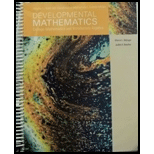
DEVELOP.MATH(3 VOLS) CUSTOM-W/MML <IC<
16th Edition
ISBN: 9781323235911
Author: BITTINGER
Publisher: Pearson Custom Publishing
expand_more
expand_more
format_list_bulleted
Concept explainers
Question
Chapter I, Problem 38ES
To determine
To calculate: The distance between points
Expert Solution & Answer
Want to see the full answer?
Check out a sample textbook solution
Students have asked these similar questions
Please show in mathematical form.
Solve the system :-
(1-x) dux (1+x) 3x + yox you to
-you -y sy
+ (1-1) 14 + (1 + x)y.
EXTER
2. A Ferris wheel has its centre 10 m above the ground and a radius of 8 m. When in operation, it completes 5
revolutions every minute.
a) Determine the equation of a sinusoidal function to represent the height of a rider, assuming the rider
starts at the bottom of the Ferris wheel.
b) Determine the height of the rider at 30 seconds.
Chapter I Solutions
DEVELOP.MATH(3 VOLS) CUSTOM-W/MML <IC<
Ch. I - Find the distance between each pair of points....Ch. I - Prob. 2DECh. I - Prob. 3DECh. I - Prob. 4DECh. I - Prob. 1ESCh. I - Prob. 2ESCh. I - Prob. 3ESCh. I - Prob. 4ESCh. I - Prob. 5ESCh. I - Prob. 6ES
Ch. I - Prob. 7ESCh. I - Prob. 8ESCh. I - Prob. 9ESCh. I - Prob. 10ESCh. I - Prob. 11ESCh. I - Prob. 12ESCh. I - Prob. 13ESCh. I - Prob. 14ESCh. I - Prob. 15ESCh. I - Prob. 16ESCh. I - Prob. 17ESCh. I - Prob. 18ESCh. I - Prob. 19ESCh. I - Prob. 20ESCh. I - Prob. 21ESCh. I - Prob. 22ESCh. I - Prob. 23ESCh. I - Prob. 24ESCh. I - Prob. 25ESCh. I - Prob. 26ESCh. I - Prob. 27ESCh. I - Prob. 28ESCh. I - Prob. 29ESCh. I - Prob. 30ESCh. I - Prob. 31ESCh. I - Prob. 32ESCh. I - Prob. 33ESCh. I - Prob. 34ESCh. I - Prob. 35ESCh. I - Prob. 36ESCh. I - Prob. 37ESCh. I - Prob. 38ESCh. I - Prob. 39ESCh. I - Prob. 40ESCh. I - Prob. 41ESCh. I - Prob. 42ESCh. I - Prob. 43ESCh. I - Prob. 44ES
Knowledge Booster
Learn more about
Need a deep-dive on the concept behind this application? Look no further. Learn more about this topic, subject and related others by exploring similar questions and additional content below.Similar questions
- 12. Determine an equation for the cosine function shown: 2π 凯 Marrow_forward1. Sketch a graph of: y = 2 sin (3x-377) +3. 2 Show your calculations for the transformation of 5 key points OR List all of the transformations.arrow_forward2. Use a compound angle formula to determine the exact value of sin 13π 12arrow_forward
- Pls help asap. Thank you!arrow_forwardII 7. Give an equation for a transformed sine function with an amplitude of 3, a period of 4' and a phase shift of 43 rad to the right. a. b. yol-2(1-1) = 3 sin 7-185(1-5) y 3 sin 8t+ = 8. Solve 2 cos x - 1 = 0 on the interval x = [0,2]. 2元 Π a. X X 3 3 元 b. x = wh 3 x = 5元 3 wy C. y= 3 sin 5 d. y= 3 sin 4x C. X -- 3 3 2元 d. ---- 3 4π 3 Jarrow_forwardPls help asap. Thank you!arrow_forward
- Pls help asap. Thank you!arrow_forwardPls help asap. Thank you!arrow_forward5. Determine the phase shift of the sinusoidal function y = 5 cos [2(x − )] + 3. a. 3 rad to the right b. 3 rad to the left c. π rad to the left d. π rad to the right a. 6. The period of the function y 2元 = sin 2x is b. π C. 1 d. 2arrow_forward
arrow_back_ios
SEE MORE QUESTIONS
arrow_forward_ios
Recommended textbooks for you
 College Algebra (MindTap Course List)AlgebraISBN:9781305652231Author:R. David Gustafson, Jeff HughesPublisher:Cengage Learning
College Algebra (MindTap Course List)AlgebraISBN:9781305652231Author:R. David Gustafson, Jeff HughesPublisher:Cengage Learning Holt Mcdougal Larson Pre-algebra: Student Edition...AlgebraISBN:9780547587776Author:HOLT MCDOUGALPublisher:HOLT MCDOUGALAlgebra & Trigonometry with Analytic GeometryAlgebraISBN:9781133382119Author:SwokowskiPublisher:Cengage
Holt Mcdougal Larson Pre-algebra: Student Edition...AlgebraISBN:9780547587776Author:HOLT MCDOUGALPublisher:HOLT MCDOUGALAlgebra & Trigonometry with Analytic GeometryAlgebraISBN:9781133382119Author:SwokowskiPublisher:Cengage Trigonometry (MindTap Course List)TrigonometryISBN:9781337278461Author:Ron LarsonPublisher:Cengage Learning
Trigonometry (MindTap Course List)TrigonometryISBN:9781337278461Author:Ron LarsonPublisher:Cengage Learning Algebra: Structure And Method, Book 1AlgebraISBN:9780395977224Author:Richard G. Brown, Mary P. Dolciani, Robert H. Sorgenfrey, William L. ColePublisher:McDougal Littell
Algebra: Structure And Method, Book 1AlgebraISBN:9780395977224Author:Richard G. Brown, Mary P. Dolciani, Robert H. Sorgenfrey, William L. ColePublisher:McDougal Littell

College Algebra (MindTap Course List)
Algebra
ISBN:9781305652231
Author:R. David Gustafson, Jeff Hughes
Publisher:Cengage Learning

Holt Mcdougal Larson Pre-algebra: Student Edition...
Algebra
ISBN:9780547587776
Author:HOLT MCDOUGAL
Publisher:HOLT MCDOUGAL

Algebra & Trigonometry with Analytic Geometry
Algebra
ISBN:9781133382119
Author:Swokowski
Publisher:Cengage

Trigonometry (MindTap Course List)
Trigonometry
ISBN:9781337278461
Author:Ron Larson
Publisher:Cengage Learning

Algebra: Structure And Method, Book 1
Algebra
ISBN:9780395977224
Author:Richard G. Brown, Mary P. Dolciani, Robert H. Sorgenfrey, William L. Cole
Publisher:McDougal Littell
Points, Lines, Planes, Segments, & Rays - Collinear vs Coplanar Points - Geometry; Author: The Organic Chemistry Tutor;https://www.youtube.com/watch?v=dDWjhRfBsKM;License: Standard YouTube License, CC-BY
Naming Points, Lines, and Planes; Author: Florida PASS Program;https://www.youtube.com/watch?v=F-LxiLSSaLg;License: Standard YouTube License, CC-BY